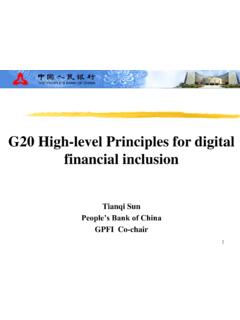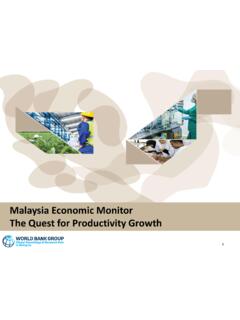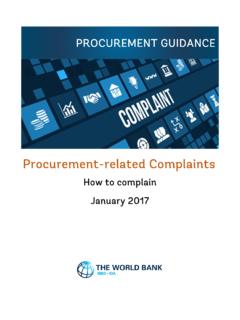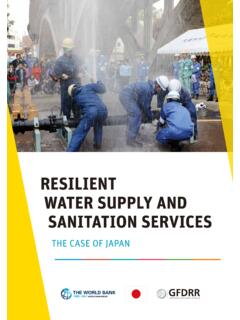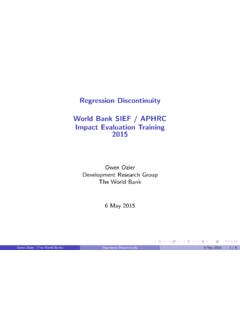Transcription of Bridging the Disability Divide through Digital Technologies
1 World development report BACKGROUND PAPER. Digital Dividends Bridging the Disability Divide through Digital Technologies Deepti Samant Raja World Bank Group Bridging the Disability Divide through Digital Technologies Background Paper for the 2016 World Development Report: Digital Dividends1. Deepti Samant Raja 1. The 2016 World Development Report (WDR) will explore the impact internet and Digital Technologies have on development. As the World Bank's flagship annual publication, the WDR is an influential guide to the economic, social, and environmental state of the world today.
2 Learn more at 1. Contents Abstract .. 3. Introduction .. 3. Understanding the Disability Divide .. 5. The ICT opportunity for persons with disabilities .. 6. Multiple channels to access content and communicate .. 7. Availability and 9. There is an app for everything .. 10. ICT for inclusive development .. 11. Education and 11. Employment and income generation .. 14. E-governance and civic 16. Financial inclusion .. 16. Disaster management .. 19. Challenges in the widespread use of accessible ICTs .. 20. Lack of enabling legal and regulatory frameworks.
3 20. Stakeholder awareness, knowledge, and capacity .. 21. Concerns about cost and affordability .. 22. Strengthening the ecosystem for accessible ICTs .. 23. Improving legislation and policy .. 25. Technical assistance and awareness raising .. 26. Mainstreaming Disability for inclusive development .. 27. Conclusion .. 27. References .. 29. 2. Abstract The exclusion and marginalization of persons with disabilities is a human rights issue as well as an economic issue for countries. Digital Technologies break traditional barriers to communication, interaction, and access to information for persons with disabilities.
4 The confluence of increasing public and private service provision through Information and Communication Technology (ICT). and the growing number of mainstream, everyday ICTs that can be used as accessible devices is changing the paradigm of technology-enabled development for persons with disabilities. This paper provides an overview of the opportunities presented by the internet and ICT for the full participation of persons with disabilities. Accessible ICT can level the playing field for persons with disabilities across life domains including education, employment, e-governance and civic participation, financial inclusion, and disaster management.
5 However, earlier divides may persist and new divides may be created when ICT-enabled development is not accessible to persons with disabilities, leading to an uneven distribution of benefits. This paper reviews the main challenges to the realization of ICT-enabled inclusive development and presents cost-beneficial policy and practice recommendations for governments and development practitioners. Introduction There is an often-cited quote by Mary Pat Radabaugh, formerly with the IBM National Support Center for Persons with Disabilities, that sums up the importance of technology in the empowerment of persons with disabilities (National Council on Disability 1993), For most people, technology makes things easier.
6 For people with disabilities, technology makes things possible. The exclusion and marginalization of persons with disabilities is a human rights issue as well as an economic issue for countries. When a significant section of society, estimated at 15 percent of the world's population, faces obstacles in receiving an education, transitioning into the labor market, and becoming economically self-sufficient, it not only undermines their rights and dignity but adds significantly to a country's welfare burden (WHO and World Bank 2011).
7 Information and Communication Technology (ICT) is increasingly enabling persons with disabilities to level the playing field in access to lifelong education, skills development, and employment (Broadband Commission for Digital Development et al. 2013). The confluence of two major trends is reshaping the paradigm on using technology to promote inclusion and full participation of persons with disabilities. The first is that the Internet and Information and Communication Technology (ICT) are becoming common and popular channels for the delivery and implementation of governance, welfare, socioeconomic development, and human rights programming (Samant, Matter, and Harniss 2012).
8 They are transforming pathways to poverty reduction by enabling direct interactions between producers and markets globally, new methods of delivering personalized public and social services quickly, different channels for income generation, and innovations in asset accumulation and 3. access to finance (Omole 2013; Spence and Smith 2010). The internet also enables multiple channels to access and contribute information, with a global reach, which can improve transparency, accountability, and monitoring of development programs and services.
9 Multiple delivery channels are being used for communication and service delivery including email, text messaging, voice communications, and video. The second is that a growing number of mainstream, everyday ICT such as mobile devices and desktop computers increasingly offer functionalities that facilitate communication and information access for persons with disabilities. Features such as text-to-speech and voice recognition, ability to change contrast and color schemes, touch and gesture input, and screen magnification which in the past required specialized standalone software and hardware are embedded within off-the- shelf ICT devices.
10 Digital Technologies enable persons with disabilities to receive information and content in the format that they can perceive and prefer. For example, a person with visual impairments can use speech-to-text functionality or software to read a website, a person with hearing impairments can use SMS or instant text messaging to communicate, and a person with mobility impairments can use voice recognition to operate and navigate their Digital device. This presents an important opportunity to break the traditional barriers of communication and interaction that persons with disabilities face and which hinder their full participation in society.

